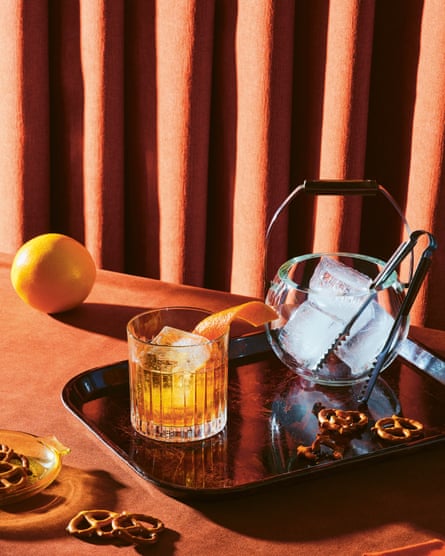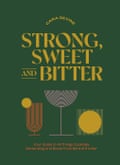The alchemy in mixing a cocktail is to make it more than the sum of its parts. No one flavour or sensation should overpower. If, when taking a sip, you find yourself thinking “too strong”, “too sweet”, “too sour”, “too bitter” – then your drink is unbalanced. Worry not! It can be saved.
The three sides of the taste triangle
The foundations of every successful cocktail – strong, sweet and bitter (or sour) – form the three sides of the triangular base that has underpinned cocktail creativity from 1806 to the present day. I call this the “taste triangle”.
Strong: The “strong” element is the driving force of your cocktail. It’s the base – what gives it body and a backbone. The strong part of the cocktail does generally have to be dry (no added sugar), and usually brings a drying effect to the whole drink whether through a savouriness, spice or minerality.
Sweet: “Sweet” is often seen as a dirty word because people have suffered through far too many sticky and sickly cocktails. But sweetness is an integral part of any cocktail as a counterpoint to sour and bitter flavours and to add body, texture and depth. If you don’t believe me, try a mojito without the sugar syrup (sadly, a reasonably common request). The rum, lime and mint jag across your palate and the already thin flavour quickly gets thinner as the ice melts, until you’re drinking sour mint water with a hint of ethanol. It’s an experience I do my best to gently talk customers out of.
Used judiciously, sugar is the salt of the cocktail world – it enhances desirable flavours while smoothing out any harshness, without being a perceivable taste itself.
Bitter or sour: The interplay between these elements and sweetness is what keep you coming back for more.
Of course, sour and bitter are two very different tastes. “Sour” flavours – acid – tingle across your palate while bitter flavours hit you at the back of the palate and linger, giving your drinks plenty of length and spice. They usually come from woody botanicals in ingredients such as amari or cocktail bitters, and often produce the kind of drink to ruminate on in a leather armchair – the Manhattan, for example.
Put the taste triangle to the test
Run out of rye but you have some rum kicking around? No problem. Orange liqueur bottle empty but you do have some apricot brandy? Sweet as. Most cocktails have variations that simply switch out one ingredient for another on the same side of the triangle.
Let’s use the margarita as an example:
Margarita (tequila, lime, orange liqueur)
Switch out sweet = toreador (tequila, lime, apricot brandy) or Tommy’s margarita (tequila, lime, agave)
Switch out strong = Pegu Club (gin, lime, orange liqueur, bitters) or cosmopolitan (vodka, lime, orange liqueur, cranberry juice)
Switch out sour = a margarita made with lemon is also delicious!

You can do this deliberately to experiment with fresh takes on some of your favourites but you can also do it on the fly if you’re missing a specific ingredient. Think about what could fulfil the same role in the taste triangle. This could be something else from your bar, or something from your kitchen – ripe berries or honey are excellent sweeteners, and vinegars can be used to add acid. It also means you don’t have to worry about having a bottle of every spirit in your bar, which can get very expensive very quickly.
How to tweak drinks using the taste triangle

So, what to do if disaster strikes – when you taste your drink, and it’s “too” something? The obvious answer is to add more of whatever ingredient is counteracting the thing that is out of balance – more sweetener if it is too sour or bitter, or vice versa. That is absolutely your first port of call – an extra bar spoon of something often works wonders – but consider your building blocks of flavour as well. Adding a large amount of a single ingredient will end up overpowering everything else. Instead, think about introducing another complementary element from the same side of the taste triangle.
Too strong? Extra dilution is often all that’s needed – try to do this by mixing on ice rather than just adding water as the chill factor is also important for making a cocktail smooth. That said, not enough sweetness can also make a drink taste too sharp or boozy – sugar rounds off the rough edges, especially if your base is spicy like rye whisk(e)y or some scotches.
Too sweet? Try combining the forces of sour and bitter. If your main balancing ingredient is citrus but you don’t want the cocktail to end up too lemony, try a dash or two of cocktail bitters to dry it out instead. Soda water, tonic water or sparkling wine also work well – lengthening out a drink decreases the perception of sweetness, with the added bonus of introducing extra bitterness (tonic) or acid (wine).
Too bitter? What starts off as woody intrigue can easily tip into unpleasant astringency. First, make sure your “strong” base can handle your bitter ingredient; rounder spirits like rum and bourbon, for instance, will stand up better to intense bitter notes than something more neutral like vodka. A little sugar also goes a long way; a bar spoon amount will often be enough to pull a rogue bitter ingredient into line without making the cocktail sweet. While not part of the taste triangle per se, salt can also help – a drop of saline solution knocks off the rough edges.
It’s good to bear in mind that bitterness is something that people perceive differently. Many bitter drinks are also quite strong, so lengthening them out can make them more approachable – trying Campari in a spritzy americano rather than in a negroni, for example.
Too sour? Look to the sweet side. But syrups and liqueurs can easily dominate with their pronounced flavours. Sometimes simple is best – just use sugar syrup! Fruit juices can add a soft sweetness that is less viscous – for instance, if the recipe calls for elderflower liqueur and you need more sweetness but don’t want it to end up too floral, apple juice is a good option.
Old fashioned – recipe
The old fashioned is really the closest drink to the original definition of a cocktail (liquor, sugar, bitters and water), but it obviously had to go out of fashion for it to become old fashioned. It originally went under the less judgmental name whiskey cocktail and was referred to as such for several decades.
So what happened for this simple but delicious drink to become passé? Well, by the 1870s bartenders had begun to have more access to liqueurs and other flavour modifiers. They got a bit excited and started pumping out “improved” whiskey cocktails. As with any attempt at modernisation there were those who resisted it. Plenty of people have laid claim to the old fashioned name, most notably the Pendennis Club in Louisville, where the story goes that a grumpy local bourbon distiller asked for a cocktail “the old-fashioned way”, so the bartender took it back to basics (with the addition of ice so clearly the grumpy bourbon distiller wasn’t against all modern comforts).

You may have seen bartenders dash a sugar cube with bitters and muddle it in the bottom of the glass. You can absolutely do it this way; I just find that you have more control (and no rogue undissolved sugar crystals) when using sugar syrup.
Taste triangle: Whiskey, sugar syrup, bitters
Ingredients
60ml whisk(e)y
7.5ml sugar syrup
2 dashes Angostura bitters
2 dashes orange bitters
Ice: large block
Garnish: orange zest twist
Equipment
Glassware: rocks glass
Jigger
Mixing glass
Julep strainer
Bar spoon
Place all the ingredients in a mixing glass and stir until desired dilution (I like to under-dilute slightly and let it develop over ice in the glass). Fold your orange twist over the top to expel the oils then use as a garnish.
Sherry cobbler – recipe
Like the mint julep, the cobbler’s rise in popularity was closely linked to the spread of commercial ice. The wine base makes this drink a more sensible choice on a hot afternoon than whisk(e)y.
Taste triangle: Amontillado sherry, PX sherry orange, lemon and bitters
Ingredients
2 wedges orange
2 wedges lemon
60ml amontillado sherry
15ml Pedro Ximénez sherry
1 dash bitters (optional)
Ice: crushed
Garnish: mint sprig, fresh berries and white granulated sugar
Equipment
Glassware: goblet or rocks glass
Jigger
Shaker tin
Hawthorne strainer
Bar spoon
Straw

Squeeze the orange and lemon into your shaker tin. Add the sherries and bitters, fill with ice and shake hard! Strain over crushed ice, or an easy fix is to “shake and dump”: don’t strain at all but pour the entire contents of your shaker into the glass if you don’t have crushed ice. The broken-up ice gives the effect you’re after. Use your bar spoon to suspend the wedges through the drink. Garnish with mint and fresh fruit, dust with sugar and – it must be served with a straw.
-
This is an edited extract from Strong, Sweet and Bitter by Cara Devine, photography by Gareth Sobey, available now through Hardie Grant ($36.99)

